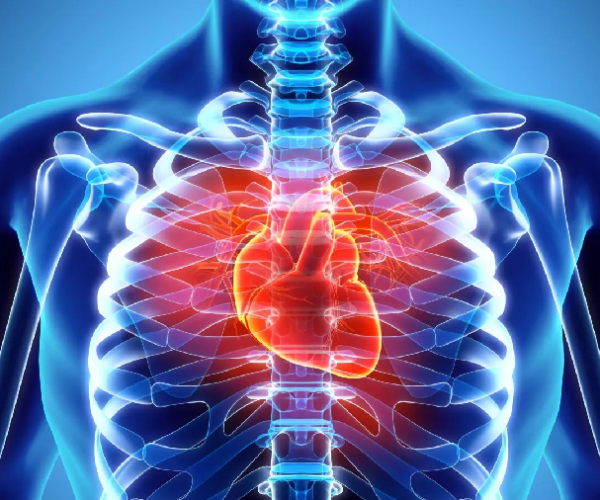How does the heart work?
The heart is a bag of muscles with blood vessels leading in and out, located between the lungs, to the left of the thorax, resting on the diaphragm and behind the sternum. The muscle mass that constitutes it is called the myocardium and comprises heart-type muscle tissue, characterised by not being subject to the will but instead working automatically. (unlike the muscles of the arm, for example).
The interior of the heart is divided into four chambers (two atria and two ventricles) separated by valves called the tricuspid (on the right) and the mitral (on the left). Thick muscular walls separate the right and left sides of the heart, acting as two coordinated hearts: the left for arterial (oxygen-rich) blood and the right for venous (oxygen-poor) blood.
The heart’s function is to pump blood to all body corners. The blood picks up oxygen as it passes through the lungs and circulates to the heart to be propelled to all parts of the body. After its journey through the body, the blood is deprived of oxygen and sent back to the heart to be pumped to the lungs to pick up more oxygen. Thus the cycle is completed.
The heart contracts and relaxes rhythmically to push blood through vessels throughout the body. The contraction phase is called systole, which corresponds to the expulsion of blood from the cavity. This systolic phase is followed by a muscle relaxation phase called diastole, in which two stages can be distinguished: one of relaxation and another of suction to draw the blood inside. Heart rate, intensity, and force of contraction and relaxation are regulated by centres in the hypothalamus (in the brain), which make the appropriate nerve impulses, and by chemicals such as adrenaline and noradrenaline, which are hormones that act on the heart.
As the heart also needs oxygen to work, there are blood vessels on the outside that provide it. If any of these vessels are obstructed, preventing the arrival of enough blood, the heart muscles degenerate, and angina pectoris or myocardial infarction occurs.
What are cardiovascular diseases?
The circulatory system forms a functional unit that extends to the entire body and has the heart as its central organ, which keeps the blood moving, so cellular life exists. Heart disease affects the whole body. Any parts that make up the heart can become ill and cause various clinical conditions that, in the long run, can evolve into a common heart failure situation. Depending on the cardiac structure affected, the following cardiovascular disorders may occur:
- Valvular diseases: They affect the valves.
- Cardiomyopathies: A condition of the muscle forming the heart’s wall (myocardium).
- Ischemic heart disease: Affects the vessels that supply the heart muscle (coronary arteries).
Common symptoms of heart disease:
Dyspnea: Difficulty breathing usually triggered by exertion but in severe cases also occurs at rest.
Angina pectoris: Strong and oppressive pain in the anterior part of the chest caused by a lack of heart irrigation (ischemia).
Palpitation: Abnormal sensation of the heartbeat felt in the chest.
The most common disease is ischemic heart disease, the leading cause of death in developed countries. This pathology is produced by atherosclerosis of the coronary arteries that affect the irrigation of the heart. Ischemic heart disease gives rise to myocardial infarction, which is the necrosis (death) of a segment of the heart due to a lack of risk due to the obstruction of the coronary artery. This obstruction is due to the formation of a thrombus in the arteriosclerosis plaque inside the artery. This clinical picture causes up to 30 per cent of mortality. Currently, there are treatment techniques that consist of unclogging the arteries early. These procedures are highly successful if performed within the first two hours (2 per cent mortality if performed within the first hour). Therefore, the patient must arrive at the hospital as soon as possible.
Angina pectoris is the chronic expression of coronary heart disease. It is manifested by chest pain when making an effort or physical exercise. The treatment of this disease goes through the adoption of preventive measures that eliminate risk factors (tobacco, cholesterol, high blood pressure, diabetes), the intake of drugs such as acetylsalicylic acid and beta-blockers, and revascularisation by catheterisation or surgery.
Cardiomyopathies, on the other hand, affect the heart muscle, which loses its ability to contract, while valvulopathies are due to the malfunction of the heart valves that do not close properly or do not open enough. Both diseases lead to heart failure because they interfere with the heart’s pumping function. However, these disorders are much less common than ischemic heart disease. They require pharmacological treatment, and in the case of valvular diseases, it may be necessary to replace the valves with prostheses. In extreme cases of cardiomyopathy, the need for a heart transplant can be assessed.




